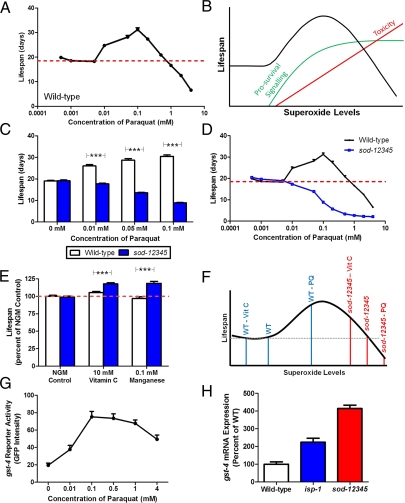Fig. 4.
Genotype determines the effect of superoxide on lifespan. (A) Increasing superoxide levels through addition of paraquat has a biphasic effect on the lifespan of wild-type worms. (B) This pattern can be explained by a model for the effect of superoxide on lifespan in which superoxide has two opposing effects on lifespan: prosurvival signaling and toxicity. Initially, the effect of the prosurvival signaling is greater than the toxic effect, resulting in a dose-dependent increase in lifespan. At higher superoxide levels, the toxic effect of superoxide overwhelms the prosurvival signaling effect leading to decreased lifespan. (C) Increasing superoxide levels with paraquat resulted in a dose-dependent decrease in sod-12345 worm lifespan but a dose-dependent increase in wild-type lifespan. (D) Paraquat did not increase the lifespan of sod-12345 worms at any concentration. (E) Decreasing ROS with 10 mM vitamin C or 0.1 mM manganese increased the lifespan of sod-12345 worms with little or no effect on wild-type lifespan. (F) Superoxide levels in sod-12345 worms are past their optimum superoxide concentration. (G) gst-4 promoter shows increased expression levels with increasing concentrations of paraquat. (H) isp-1 and sod-12345 worms show increased gst-4 expression, suggesting elevated levels of superoxide. Results from the paraquat and antioxidant survival studies are the average of at least three independent trials of at least 20 worms per strain per trial. Error bars indicate SEM. ***P < 0.001.

